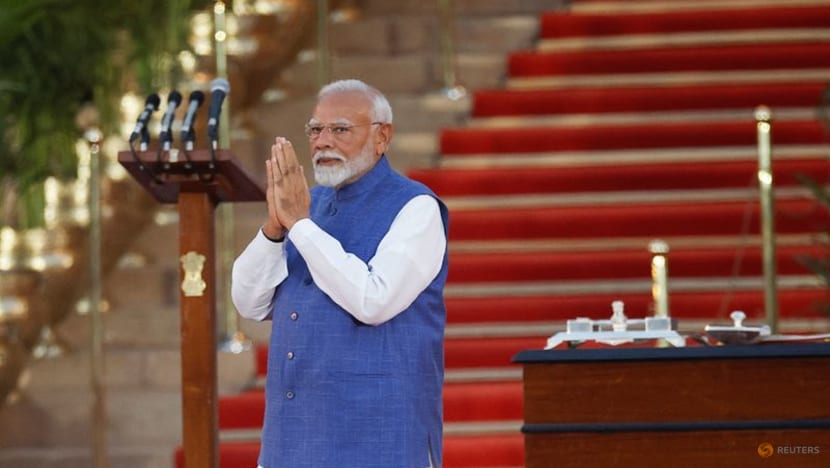More women voted for opposition in India election, but support for Modi holds steady
While Prime Minister Narendra Modi’s Bharatiya Janata Party lost 63 seats, its vote share this election dropped only slightly – by less than 1 per cent.


This audio is generated by an AI tool.
NEW DELHI: Indian Prime Minister Narendra Modi’s Bharatiya Janata Party (BJP) may have suffered a shock loss of seats in the recent general election, but support for the country’s most popular politician remains strong.
Experts told CNA that razor-thin margins were key to the INDIA (Indian National Developmental Inclusive Alliance) opposition coalition’s victory in key battleground states, including the most populous state of Uttar Pradesh.
The INDIA bloc also gained 7 per cent more votes from women compared with the last election in 2019.
Results in the nation’s marathon election were announced earlier this month on Jun 4.
While commentators and exit polls had predicted an overwhelming victory for Mr Modi and the ruling BJP, the party ultimately failed to win a parliamentary majority for the first time in a decade.
The BJP formed the government with allied parties, leading the 15-member National Democratic Alliance (NDA) and a coalition total of 293 seats in parliament to control the legislature.
Mr Modi was sworn in for a rare third term in office on Jun 9.
VOTE SHARE A KEY INDICATOR
CNA’s post-election analysis showed that despite what looked like a dramatic setback for the BJP, its vote share this year dropped only slightly – by less than 1 per cent.
However, such a small margin managed to cause huge upheavals.
A large number of BJP’s seats fell to the INDIA bloc, particularly in the northern and central parts of the country. The bloc – led by the main opposition Indian National Congress party – secured a historic 232 seats.
BJP only secured 240 out of 543 parliamentary seats. This was much lower than the target of 400 seats that Mr Modi set during the election campaign, and the 303 seats that it won at the last polls five years ago.
“Vote share, in my view, is the perfect way to evaluate the performance of any political party,” said Associate Professor Hilal Ahmad from the Centre for the Study of Developing Societies, an Indian research institute for social sciences and humanities.
“Statistically speaking, in that sense, BJP’s performance is remarkably well."
Uttar Pradesh was a dramatic example of how small dips in votes led to big drops in seats.
In 2019, the BJP and its allies swept the state with 62 seats. It only won 36 seats this year, losing the state to the INDIA coalition.
However, the drop in votes was relatively small – 8 per cent, from 49 per cent in 2019 to 41 per cent this time round.
The loss shocked many because the BJP even lost in the district that includes the city of Ayodhya – where the controversial Ram temple is located.
Its inauguration by Mr Modi in January this year was seen to guarantee his victory in the district.

FOCUS ON RELIGIOUS IDENTITY POLITICS BACKFIRED
Analysts said the BJP's focus on religious identity politics backfired in the end.
Mr Jagdeep Chhokar, founder of non-profit Association for Democratic Reforms, told CNA: “Unemployment, poverty, state of the economy, deprivation – these were the main issues I think which got the electorate to vote in favour of the opposition.”
Data also showed an improvement in opposition performance among women, a key demographic. Female voters have become increasingly significant in the Indian electorate over the past two decades, turning out in equal numbers to men.
In response, politicians have stepped up their game to woo female voters.
While on the campaign trail, the BJP banked on subsidised cooking gas and free rations. Meanwhile, the INDIA bloc promised to reserve half of government jobs for women if it came into power.
These overtures could have helped the bloc gain 7 per cent more support among women this election.
It won 34 per cent of their votes, possibly from new and non-aligned voters, while the BJP and its allies kept their vote share among women steady at 43 per cent.
MORE YOUTHS SUPPORTED BJP
Youths were another crucial group for both sides, with 18 million first-time voters registered in this year’s elections.
The opposition hoped to secure their vote by promising jobs and apprenticeships, while the NDA coalition offered more support for entrepreneurs.
In the end, the BJP’s message resonated with younger voters. Only 33 per cent of voters aged between 25 and 35 voted for the INDIA bloc, while 45 per cent cast their ballots for the NDA.
BJP had relied heavily on Mr Modi’s reputation as a strong leader, as well as the promise of a booming economy. This was despite concerns that joblessness could hurt the party’s chances with this demographic.
Nearly 83 per cent of the country’s unemployed are its youth.
Nevertheless, some analysts said that relying too heavily on Mr Modi’s personal brand will be detrimental to BJP, and that losing its majority in parliament should instead spark introspection within the party.

Assoc Prof Ahmad said the BJP has “reached a level” where it would be “next to impossible” for them to win a municipality election without him, because “the second-layer leadership is currently absent in the party”.
BJP’s electoral strategy will be put to test once again later this year when three Indian states head to regional polls.
Observers said it will be worth watching if the party’s campaign relies on grassroot leaders who understand the local issues, or on Mr Modi’s brand – a strategic choice that could decide the longevity of BJP.



















